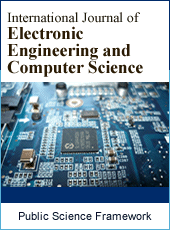International Journal of Electronic Engineering and Computer Science
Articles Information
International Journal of Electronic Engineering and Computer Science, Vol.1, No.2, Nov. 2016, Pub. Date: Aug. 25, 2016
An Augm ented Reality Model Sharing Platform for Virtual Design Critiques
Pages: 45-48 Views: 3904 Downloads: 975
[01]
Tilanka Chandrasekera, Department of Design, Housing and Merchandising, Oklahoma State University, Stillwater, USA.
[02]
Kirthi Krishnamurthy, Department of Electrical and Computer Engineering, Oklahoma State University, Stillwater, USA.
This paper presents an application of Augmented Reality, which allows users to share, review and provide feedback using Augmented Reality objects. The primary objective is to use this application and integrate it in to a virtual critique platform to be used in Architectural and Interior Design critiques/reviews.
Augmented Reality, Design Critiques, Architecture, Virtual Reality, Online Design Education
[01]
Abdellatif, R. (2008). Distance Learning in SecondLife: A Virtual Crit. Submission Categories, 47.
[02]
Anderson, L., Esser, J., & Interrante, V. (2003). A virtual environment for conceptual design in architecture.
[03]
Azuma, R. T. (1997). A survey of Augmented Reality. Presence-Teleoperators and Virtual Environments, 6(4), 355-385.
[04]
Broadfoot, O., & Bennett, R. (2003). Design studios: Online? Comparing traditional face-to-face design studio education with modern Internet-based design studios.
[05]
Burke, J. W., McNeill, M., Charles, D., Morrow, P. J., Crosbie, J., & McDonough, S. (2010). Augmented Reality games for upper-limb stroke rehabilitation. Games and Virtual Worlds for Serious Applications (VS-GAMES), 2010 Second International Conference on, IEEE.
[06]
Chen, Y.-C. (2006). A study of comparing the use of Augmented Reality and physical models in chemistry education. Proceedings of the 2006 ACM international conference on Virtual reality continuum and its applications, ACM.
[07]
Chandrasekera, T., Yoon, S.-Y (2014). Using Augmented Reality tools to enhance design creativity. Paper presented at the Environmental Design Research Association Conference, New Orleans.
[08]
Chandrasekera, T., Yoon, S.-Y (2015a) Adopting Augmented Reality in Design Communication: Focusing on Improving Spatial Abilities, The International Journal of Architectonic, Spatial, and Environmental Design, Volume 9, Issue 1, March 2015, Pages 1-14.
[09]
Chandrasekera, T. (2015) towards an online based design critique framework for design education, International Journal of Education and Information Technology, Volume 1, Issue 3, June 2015, Pages 61-69.
[10]
Chandrasekera, T. (2014) Using Augmented Reality Prototypes in Design education, Design and Technology Education: An International Journal, Volume 19, Issue 3, November 2014, Pages 33-42.
[11]
Chandrasekera, T., & Yoon, S. Y. (2015b). The Effect of Tangible User Interfaces on Cognitive Load in the Creative Design Process. In Mixed and Augmented Reality-Media, Art, Social Science, Humanities and Design (ISMAR-MASH'D), 2015 IEEE International Symposium on Mixed and Augmented Reality (pp. 6-8). IEEE.
[12]
Chastain, T., & Elliott, A. (2000). Cultivating design competence: online support for beginning design studio. Automation in Construction, 9(1), 83-91.
[13]
Kim, M. J., & Maher, M. L. (2008). The impact of tangible user interfaces on designers' spatial cognition. Human–Computer Interaction, 23(2), 101-137.
[14]
Kvan, T. (2001). The pedagogy of virtual design studios. Automation in construction, 10(3), 345-353.
[15]
Martín-Gutiérrez, J., Luís Saorín, J., Contero, M., Alcañiz, M., Pérez-López, D. C., & Ortega, M. (2010). Design and validation of an augmented book for spatial abilities development in engineering students. Computers & Graphics, 34(1), 77-91.
[16]
Okeil, A., (2002). Architectural Design Critique in Multi-User Online Virtual Environment (ARCHIMOVEMENTS). An experimental research project on Architectural Education submitted to the UAE e-learning IT Challenge, UAE.
[17]
Rabbi, I., Ullah, S., & Khan, S. U. (2012). Augmented Reality Tracking Techniques—a systematic literature. IOSR Journal of Computer Engineering (IOSRJCE), 2(2), 23-29.
[18]
Reas, C., & Fry, B. (2007). Processing: a programming handbook for visual designers and artists (No. 6812). Mit Press.
[19]
Schnabel, M. A., Kvan, T., Kruijff, E., & Donath, D. (2001). The first virtual environment design studio.

ISSN Print: Pending
ISSN Online: Pending
Current Issue:
Vol. 6, Issue 3, September Submit a Manuscript Join Editorial Board Join Reviewer Team
ISSN Online: Pending
Current Issue:
Vol. 6, Issue 3, September Submit a Manuscript Join Editorial Board Join Reviewer Team
| About This Journal |
| All Issues |
| Open Access |
| Indexing |
| Payment Information |
| Author Guidelines |
| Review Process |
| Publication Ethics |
| Editorial Board |
| Peer Reviewers |


